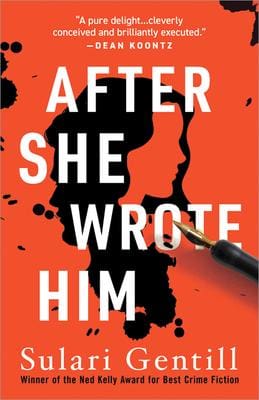It’s not every author whose latest book is reviewed in The Wall Street Journal. Sulari Gentill is the author of After She Wrote Him, now available from Sourcebooks/Poisoned Pen Press. You can order a copy, along with Gentill’s other books, through the Web Store. https://bit.ly/2N5KsYB

We’re proud to share the review from The Wall Street Journal.
“In Sulari Gentill’s clever metafiction, a pair of writers, each perhaps a figment of the other’s imagination, write each other into tricky situations.
Fiction authors are sometimes asked: “Do your characters ever take control of the stories you’re writing?” Sulari Gentill’s “After She Wrote Him” (Poisoned Pen, 233 pages, $16.99) pushes that question even further. “What if you wrote of someone writing of you?” asks this book at the outset. “In the end, which of you would be real?”
Madeleine “Maddie” d’Leon, a 30-year-old lawyer-turned-author living in Australia, is the creator of a series of mysteries about a “working-class, feminist” housemaid “who solves crimes by looking at what people throw away.” Maddie wants to create a different protagonist for her next mystery: a wealthy “literary” novelist who pens “the kind of worthy, incomprehensible stuff that wins awards.” Her new character is the “intriguing” and “brooding” Edward McGinnity, and he soon takes on a life of his own. As Maddie tells her agent: “I can see him so clearly. It’s like he exists, like I’m being allowed to watch.”
Edward, in Maddie’s telling, is also writing a book—one involving a crime writer named Madeleine d’Leon. “It’s an exploration of an author’s relationship with her protagonist,” he tells his artist friend Willow Meriwether, “an examination of the tenuous line between belief and reality, imagination and self, and what happens when that line is crossed.” (“I’m not sure what that means,” Willow replies, “but it does sound award-winning.”)
What we have, then, in “After She Wrote Him,” is a tale of two writers, each a figment of the other’s imagination. In Ms. Gentill’s clever construction, both characters inhabit a world in which reality and make-believe blur and blend.
This meta-fiction becomes a whodunit when, at a gallery opening for Edward’s friend Willow, a waspish critic is knocked down a flight of stairs and killed. Who might have murdered him? Willow, whose show he’d just trashed in a review? Edward, who is in unrequited love with the married Willow?
As Edward (thanks to his quick temper and intemperate behavior) becomes the police’s main suspect, Maddie is appalled at the situation she has created for her handsome and vulnerable hero. She barely hears her real-life husband’s complaints—as written by Edward—that their marriage is suffering from her fictional obsession. She’s fallen madly in love with her protagonist, and the feeling is reciprocated.
“After She Wrote Him” careens toward a fateful culmination as Maddie and Edward write each other into personal limbos that, it seems, will prevent them from saving one another. Readers are left to their own devices to escape from this infinity of mirrors.”
